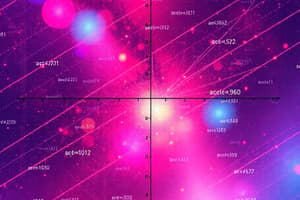Podcast
Questions and Answers
Which of the following equations represents a linear equation in two variables in standard form?
Which of the following equations represents a linear equation in two variables in standard form?
- $y = a/x + b$
- $ax^2 + by = c$
- $y = mx + b$
- $ax + by = c$ (correct)
What condition must be met for a pair of values, ((x, y)), to be considered a solution to a linear equation in two variables?
What condition must be met for a pair of values, ((x, y)), to be considered a solution to a linear equation in two variables?
- The values of \(x\) and \(y\) must satisfy the equation. (correct)
- The values of \(x\) and \(y\) must be integers.
- The value of \(x\) must be greater than the value of \(y\).
- The values of \(x\) and \(y\) must both be positive.
In the slope-intercept form of a linear equation, (y = mx + b), what does the variable (m) represent?
In the slope-intercept form of a linear equation, (y = mx + b), what does the variable (m) represent?
- The value of \(y\) when \(x\) is zero.
- The y-coordinate of the point where the line crosses the x-axis.
- The x-coordinate of the point where the line crosses the y-axis.
- The rate of change of \(y\) with respect to \(x\). (correct)
Given two points ((x_1, y_1)) and ((x_2, y_2)) on a line, which formula is used to calculate the slope ((m)) of the line?
Given two points ((x_1, y_1)) and ((x_2, y_2)) on a line, which formula is used to calculate the slope ((m)) of the line?
Lines (L_1) and (L_2) are perpendicular. If the slope of (L_1) is 2/3, what is the slope of (L_2)?
Lines (L_1) and (L_2) are perpendicular. If the slope of (L_1) is 2/3, what is the slope of (L_2)?
Which method involves solving one equation for one variable and substituting that expression into the other equation?
Which method involves solving one equation for one variable and substituting that expression into the other equation?
In the elimination method, what is the purpose of multiplying one or both equations by a constant?
In the elimination method, what is the purpose of multiplying one or both equations by a constant?
When graphing a system of linear equations, what does the point of intersection represent?
When graphing a system of linear equations, what does the point of intersection represent?
Under what condition does a system of linear equations have no solution?
Under what condition does a system of linear equations have no solution?
What type of real-world problem can be modeled using the equation (d = rt)?
What type of real-world problem can be modeled using the equation (d = rt)?
A company's cost equation is given by $C = 200 + 5x$, where $x$ is the number of units produced. If each unit is sold for $8, what is the break-even point?
A company's cost equation is given by $C = 200 + 5x$, where $x$ is the number of units produced. If each unit is sold for $8, what is the break-even point?
Two cars start from the same point and travel in the same direction. One car travels at 40 mph and the other travels at 55 mph. How long will it take for them to be 75 miles apart?
Two cars start from the same point and travel in the same direction. One car travels at 40 mph and the other travels at 55 mph. How long will it take for them to be 75 miles apart?
A chemist wants to mix a 30% saline solution with a 60% saline solution to produce 600 ml of a 50% solution. How much of the 30% solution is needed?
A chemist wants to mix a 30% saline solution with a 60% saline solution to produce 600 ml of a 50% solution. How much of the 30% solution is needed?
What is a critical first step in effectively solving word problems involving linear equations?
What is a critical first step in effectively solving word problems involving linear equations?
A system of equations yields identical lines when graphed. What does this indicate about the number of solutions?
A system of equations yields identical lines when graphed. What does this indicate about the number of solutions?
Consider the system of equations: $y = 2x + 3$ and $y = 2x - 5$. What can you conclude about the solutions to this system?
Consider the system of equations: $y = 2x + 3$ and $y = 2x - 5$. What can you conclude about the solutions to this system?
Which of the following applications is best modeled using a system of linear equations?
Which of the following applications is best modeled using a system of linear equations?
A rectangle has a perimeter of 28 inches. The length is two inches more than the width. What system of equations can be used to find the length (l) and width (w)?
A rectangle has a perimeter of 28 inches. The length is two inches more than the width. What system of equations can be used to find the length (l) and width (w)?
You are offered two job options: Job A pays $15 per hour, and Job B pays $12 per hour plus a $90 weekly bonus. How many hours must you work for the pay to be equal?
You are offered two job options: Job A pays $15 per hour, and Job B pays $12 per hour plus a $90 weekly bonus. How many hours must you work for the pay to be equal?
When solving a system of equations graphically, what does it mean if the two lines appear to be the same line?
When solving a system of equations graphically, what does it mean if the two lines appear to be the same line?
Flashcards
Linear Equation
Linear Equation
A linear equation is in the form ax + by + c = 0, with a, b, and c as real numbers, and a and b not both zero.
Standard Form
Standard Form
ax + by + c = 0
Solution of a Linear Equation
Solution of a Linear Equation
A pair of values for x and y that make the equation true.
Graphing Linear Equations
Graphing Linear Equations
Signup and view all the flashcards
Slope-Intercept Form
Slope-Intercept Form
Signup and view all the flashcards
Slope Formula
Slope Formula
Signup and view all the flashcards
Parallel Lines
Parallel Lines
Signup and view all the flashcards
Perpendicular Lines
Perpendicular Lines
Signup and view all the flashcards
System of Linear Equations
System of Linear Equations
Signup and view all the flashcards
Substitution Method
Substitution Method
Signup and view all the flashcards
Elimination Method
Elimination Method
Signup and view all the flashcards
Graphical Method
Graphical Method
Signup and view all the flashcards
Unique Solution
Unique Solution
Signup and view all the flashcards
No Solution
No Solution
Signup and view all the flashcards
Infinitely Many Solutions
Infinitely Many Solutions
Signup and view all the flashcards
Cost Analysis
Cost Analysis
Signup and view all the flashcards
Distance-Rate-Time Relationship
Distance-Rate-Time Relationship
Signup and view all the flashcards
Mixture Problems
Mixture Problems
Signup and view all the flashcards
Problem Solving Strategy
Problem Solving Strategy
Signup and view all the flashcards
Verifying Solutions
Verifying Solutions
Signup and view all the flashcards
Study Notes
Linear Equations in Two Variables
- Equations are written in the form (ax + by + c = 0).
- (a), (b), and (c) represent real numbers.
- Both (a) and (b) cannot be zero.
Standard Form
- (ax + by + c = 0) is the standard form of a linear equation in two variables.
Solutions of Linear Equations
- Solutions are pairs of values for (x) and (y) that satisfy the equation.
- Each solution corresponds to a point on the line representing the equation.
Graphing Linear Equations
- Graphing involves plotting the line that represents all solutions to the equation.
- At least two points satisfying the equation are needed to graph it.
- Plot the points on a coordinate plane and draw a straight line through them.
- The line visually represents all possible solutions.
Slope-Intercept Form
- Expressed as (y = mx + b).
- (m) is the slope.
- (b) is the y-intercept.
- The slope (m) indicates the rate of change of (y) with respect to (x).
- The y-intercept (b) is where the line crosses the y-axis.
Finding the Slope and Intercept
- Given two points ((x_1, y_1)) and ((x_2, y_2)), the slope (m) is calculated as (m = \frac{y_2 - y_1}{x_2 - x_1}).
- The y-intercept is found by substituting the slope and one point into (y = mx + b) and solving for (b).
Parallel and Perpendicular Lines
- Parallel lines share the same slope.
- Perpendicular lines have slopes that are negative reciprocals, so (m_1 \cdot m_2 = -1).
Systems of Linear Equations
- Consist of two or more linear equations with the same variables.
- The solution is the set of values for the variables that satisfy all equations.
Methods to Solve Systems of Equations
- Substitution: Solve one equation for one variable and substitute into the other.
- Elimination: Add or subtract equations to eliminate one variable.
- Graphical: Graph both equations and find the intersection point.
Substitution Method
- Solve one equation for one variable.
- Substitute the expression into the other equation.
- Solve for the remaining variable.
- Substitute the value back into one of the original equations to find the other variable’s value.
Elimination Method
- Multiply equations by constants so that one variable's coefficients are equal or opposite.
- Add or subtract the equations to eliminate one variable.
- Solve for the remaining variable.
- Substitute the value back into an original equation to find the eliminated variable’s value.
Graphical Method
- Graph each equation on the same coordinate plane.
- Identify the point of intersection.
- The intersection point’s coordinates are the solution to the system.
Types of Solutions
- Unique Solution: Lines intersect at one point.
- No Solution: Lines are parallel and do not intersect.
- Infinitely Many Solutions: Lines are identical and overlap.
Applications in Real-World Scenarios
- Used to model relationships between two variables.
- Represent quantities that change at a constant rate.
- Applications include cost analysis, distance-rate-time relationships, and mixture problems.
Cost Analysis
- Models the relationship between cost and quantity.
- Can represent total manufacturing cost with a fixed setup cost and a variable cost per item.
Distance-Rate-Time Relationships
- Modeled using the formula (d = rt).
- (d) represents distance, (r) represents rate (or speed), and (t) represents time.
Mixture Problems
- Combine substances with different concentrations.
- Linear equations determine the amount of each substance needed.
Problem Solving Strategy
- Read the problem and identify knowns and unknowns.
- Assign variables to the unknowns.
- Write a system of linear equations representing the problem.
- Solve the system using substitution, elimination, or graphing.
- Interpret the solution in the context of the problem.
Example: Cost Analysis
- A company makes t-shirts with a fixed cost of $500 and a variable cost of $8 per shirt, selling them for $12 each
- To determine the break-even point, (x) is the number of t-shirts
- Total cost is (C = 500 + 8x)
- Total revenue is (R = 12x)
- Set (C = R):
- (500 + 8x = 12x)
- (500 = 4x)
- (x = 125)
- The break-even point is 125 t-shirts.
Example: Distance-Rate-Time
- Two cars start at the same point, traveling in opposite directions at 60 mph and 50 mph
- To find how long until they are 330 miles apart, (t) is the time in hours
- The first car's distance is (d_1 = 60t)
- The second car's distance is (d_2 = 50t)
- Total distance is (d_1 + d_2 = 330)
- (60t + 50t = 330)
- (110t = 330)
- (t = 3)
- It will take 3 hours for the cars to be 330 miles apart.
Example: Mixture Problem
- A chemist mixes a 20% acid solution with a 50% acid solution to get 100 ml of a 30% acid solution.
- Let (x) be the amount of 20% solution and (y) the amount of 50% solution.
- Total volume: (x + y = 100)
- Amount of acid: (0.20x + 0.50y = 0.30(100))
- Solving the system:
- (x + y = 100)
- (0.20x + 0.50y = 30)
- From the first equation, (y = 100 - x)
- Substitute:
- (0.20x + 0.50(100 - x) = 30)
- (0.20x + 50 - 0.50x = 30)
- (-0.30x = -20)
- (x = \frac{20}{0.30} = \frac{200}{3} \approx 66.67) ml
- (y = 100 - x = 100 - \frac{200}{3} = \frac{100}{3} \approx 33.33) ml
- Approximately 66.67 ml of the 20% solution and 33.33 ml of the 50% solution are needed.
Concepts and Important Points
- Systems can have one, none, or infinitely many solutions.
- Verify solutions by substituting values back into the original equations.
- Define variables and set up equations carefully in word problems.
- Linear equations are fundamental in algebra with applications in science, engineering, economics, and computer science.
Studying That Suits You
Use AI to generate personalized quizzes and flashcards to suit your learning preferences.




